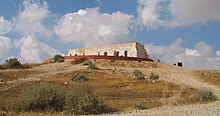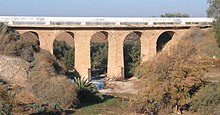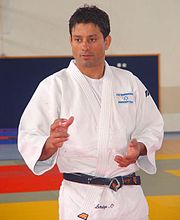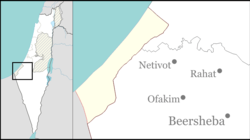Ofakim
Ofaqim
אוֹפָקִים / אֳפָקִים افقيم | |
|---|---|
 | |
| Coordinates: 31°19′N 34°37′E / 31.317°N 34.617°E | |
| Country | |
| District | Southern |
| Founded | 19 April 1955 |
| Government | |
| • Mayor | Yitzhak Danino |
| Area | |
| • Total | 10,273 dunams (10.273 km2 or 3.966 sq mi) |
| Population (2022)[1] | |
| • Total | 35,506 |
| • Density | 3,500/km2 (9,000/sq mi) |
| Name meaning | Horizons |
| Website | http://www.ofaqim.muni.il |
Ofakim (Hebrew: אֳפָקִים ʾŎfāqīm, or אוֹפָקִים ʾŌfāqīm, lit. "horizons") is a city in the Southern District of Israel, 20 kilometers (12.4 mi) west of Beersheba. It achieved municipal status in 1955. It has an area of 10,000 dunams (~3.9 sq mi; 10 km2). In 2022, it had a population of 35,506.[1]
Established as a
History

Prior to 1948, the area was known as Khirbat Futais (
Ofakim was established in 1955 as an urban center for the rural communities in the area adjacent to the Ottoman fort and on the site of Khirbat Futais.
In the late 1950s, the construction industry was still the main employer, and some residents also worked in agriculture nearby, but industry also began to be established in Ofakim, starting with a diamond polishing plant, followed by two textile factories that opened in 1959. At the same time, the town's streets were paved, public parks were established, and schools were founded. In 1961, the population was 4,600.
As in other development towns, the industrial sector historically played an important part in Ofakim's economy. In 1972, 32% of the salaried workers (754 people) were in this sector, and in 1983—924 people (23%). During this period, the textile industry grew to dominate Ofakim's economy. Numerous textile plants were set up, and the industry employed by far the most workers, ranging from 72% (1982–83) to 82% (1972). The Of–Ar (short for Ofakim–Argentina) textile factory was a major employer.[8] In 1983, the population had grown to 12,600.
Ofakim's economy declined after Israeli textile manufacturers began closing their factories in Israel to move their production to other countries with lower labor costs, mainly in Southwest Asia, and to
In 1997, it had the highest unemployment rate in Israel, at 15.3%.[10] It also had the highest unemployment rate in 2004, at slightly over 14%.[11] In 2008, Haaretz reported: "Nearly one-third of the inhabitants are supported by the welfare department and hundreds of families receive aid, including food, from non-profit organizations. Many of the inhabitants in their 50s and 60s have been dreaming of fleeing Ofakim since they were 20. When they retire, they leave."[12]
In the 2007, the Israeli Interior Ministry dismissed Ofakim mayor Avi Asaraf and his entire city council from their posts for failing to implement a recovery plan for Ofakim.[13] Zvika Greengold became the new mayor.
Throughout the 2000s and 2010s, Ofakim gradually saw improvements in its economy. Tax incentives were given to open new factories in Ofakim, and a branch of MATI, an organization that supports small businesses, was opened. The high-tech industry also entered Ofakim. The city is currently undergoing a series of major development projects.
Ofakim was infiltrated by Palestinian forces on 7 October during the
Demographics

In 2010, about one-fifth of the residents were
According to the Central Bureau of Statistics, Ofakim had a population of 30,662 in 2019, and the population is growing at a rate of 1.4% a year. The percentage of the share of the Arab Palestinian population of Ofakim is very small and about 0.7%.[1]
Economy

In 2013, about 40% of Ofakim's residents worked in the city. There were about 20 factories in Ofakim on 2,000 dunams of land. Some residents also work in high-tech.[16]
Education
In 2001, there were 21 schools and 4,704 students in the city – 13 elementary schools (3,079 students), and 8 high schools (1,625 students). 43.3% of 12th grade students were entitled to a matriculation certificate.
Sports
One of Israel's 14 tennis centers is located in Ofakim.[17] It opened in 1990 and has six courts. The city also has a soccer stadium. The Nahal Shomriya cycling route around Ofakim was inaugurated in 2010. The 60-centimeter-wide single route winds through 1,500 dunams (approx 375 acres) in Ofakim Forest, passing through Nahal Shomriya and Nahal Patish, and looping around eight local moshavim.[18]
Transportation

Ofakim is accessible by Highway 25 and Route 241. Ofakim is connected to the Trans-Israel Highway via Highway 264.
The Ashkelon–Beersheba railway, a new railway line which connected Ofakim with Tel Aviv and Beersheba, was inaugurated in August 2015, which finally connected the railway line between Ashkelon and Beersheba. The Ofakim railway station was opened on December 31, 2015.[19] The rail line connects Ofakim to Beersheba in the Southeast, and to Ashkelon and beyond to Greater Tel Aviv in the Northwest.
Ben Gurion Airport, the closest major international airport, is located about 101km North from Ofakim, which can be accessed via a drive along the Trans-Israel Highway.
Urban development plans

The city has begun to develop from 2015 onward after years of stagnation. Thousands of new housing units, commercial and employment centers, and a youth center which included a cinema were built. Ofakim Railway Station was completed in December 2015 with a car park for 1,000 cars.[12] Next to the train station, a new neighborhood specially designed to have affordable prices for young people, is being built as part of the "Noah Initiative", which was started by activists from Tel Aviv.[20][21]
In 2017, a new agreement was signed to build 14,436 housing units in four new neighborhoods and one established neighborhood, which will greatly increase the city's population. In addition, the agreement stipulated the development of an industrial zone in southern Ofakim, increased funding for infrastructure and urban renewal projects, and the construction of a new road between Ofakim and Ramon Airport. The plan aims to double the city's population.[22][23] High-rise construction of buildings up to 13 stories is also planned.
Notable people

- Shimshon Pincus (c. 1944–2001), rabbi
- Oren Smadja (born 1970), Olympic judoka
- Robert Tiviaev (born 1961), former Knesset member
References
- ^ a b c "Regional Statistics". Israel Central Bureau of Statistics. Retrieved 21 March 2024.
- ^ a b Hasson, Nir (8 October 2023). "The Israeli Town of Ofakim Has Been Cleared of Hamas Fighters but the Blood and Shock Remain". Haaretz. Archived from the original on 8 October 2023. Retrieved 9 October 2023.
- ^ Dabbagh, Mustafa Murad. “Futeis (Village) (فطيس (قرية)).” Essay. In Our Country Palestine (بلادنا فلسطين) 1, 2st ed. Vol. 1. Beirut, 1966 https://www.palestinapedia.net/فطيس-قرية/.
- ^ Aweili, Muhammad Abu. “The Negev: Meeting with Haj Abu Mahir Abu Ataya from Al-Tahiya Tribe!! (النقب : لقاء مع الحاج ابو ماهر ابو عطايا من قبيله التياها!!).” ديار النقب, April 26, 2015. http://deyaralnagab.net/print.php?content=4&id=230.
- ISBN 978-0-521-00967-6.
- ^ a b "Go south, young men (and women)". Haaretz.
- ^ a b "New horizons for Ofakim". Haaretz.
- ISBN 978-965-217-298-3.
- ^ "Archives". Los Angeles Times.
- ^ "Peak 145,600 Job Seekers in July - Globes". 18 August 1997.
- ^ "Unemployment falls, but do statistics lie?". Haaretz.
- ^ a b New Horizons for Ofakim
- ^ "Ofakim Mayor, City Council Dismissed for Failing to Implement Recovery Plan". The Jerusalem Post. August 29, 2007. Retrieved April 16, 2019.
- Times of Israel. Retrieved October 7, 2023.
- ^ Goldman, Adam; Koplewitz, Gal (26 October 2023). "Alone and Outgunned, Israeli Police Fought Hamas From House to House".
- ^ "Ofakim, Israel | Nefesh B'Nefesh".
- ^ Tennis doubles coexistence program
- ^ KKL (February 22, 2010). "Riding and Building New Ofakim - Shomriya Cycling Route". The Jerusalem Post. Retrieved April 16, 2019.
- ^ "Next stop: Ofakim" (in Hebrew). Arutz Sheva. Retrieved 11 January 2016.
- ^ Tress, Luke (May 11, 2016). "Building anew in the Negev". The Times of Israel. Retrieved April 16, 2019.
- ^ "מעריב תגיות | אופקים".
- ^ "The New Ofakim Pact | Jewish Federation of Greater MetroWest NJ". Archived from the original on 2017-08-25. Retrieved 2017-08-25.
- ^ "Agreement for 14,000 Housing Units Just Signed". Globes. May 29, 2017. Retrieved April 16, 2019.
External links
- Weaving community: Labour in Ofakim
- Works of communal art
- Survey of Western Palestine, Map 24: IAA, Wikimedia commons




